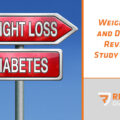Losing weight is easy, but keeping it off is harder. Everybody loses weight, if they are paying attention to it. However, it’s the long-term sustainable weight loss that is the key to health. You should avoid the yo-yo diet and practice seven real strategies for long-term weight loss.
Nearly every research study on dietary intervention demonstrates that even the placebo groups lose weight, likely from something called the Hawthorne effect, where bringing attention to something causes it to temporarily change behavior.
This also explains why nearly every weight loss dietary intervention shows weight regain within two years. We have an internal set point that causes us to return to a perceived correct weight, based upon hormonal signaling from our fat cells. This constant hormonal signaling overwhelms any willpower that we might display in the short term.
Using our own hormonal system to our benefit, instead of fighting with it, is the only way to maintain long-term weight health.
What’s wrong with regaining weight if taking it off again is possible (the yo-yo diet effect)? Most diets succeed in the short term but fail in the long term. In fact, over 95% of patients, after a dieting cycle and then refeeding, are heavier than they started. This is called yo-yo dieting. Calorie restriction and deprivation lead to a yo-yo dieting effect, with refeeding resulting in supernormal weight gain, even without binge eating. In a rat study, repetitive dieting cycles documented that second-time weight loss velocity was 50% slower on same calories and regain was nearly 300% faster.
Under normal circumstances, fat cell size increases and decreases, but the number of cells remains static. In a dietary restriction model, after refeeding occurs with rapid regain of weight, progenitor fat cells differentiate increasing the number of adipocytes by approximately 50%. Ad libitum feeding does not reduce until the adipocyte size returns to its pre-dieting size, but now there are more adipocytes, so total mass increases, resulting in an overshooting of the pre-dieting fat mass.
Sometimes this pattern of yo-yo dieting is externally forced, such as in low-income families where food-insecurity leads to cycles of food deprivation and overeating. Those who are eating less or skipping meals to stretch food budgets may overeat when food becomes available, resulting in chronic ups and downs in food intake that can contribute to weight gain, a forced type of yo-yo dieting. Paradoxically, even though the global calorie consumption is less, the patient is gaining weight.
(Bruening et al., 2012; Dammann & Smith, 2010; Olson et al., 2007).
Yo-yo dieting not only affects the total fat mass, but also affects the net muscle mass, or the fat: muscle ratio. With the initial cycle of dieting, the fat: muscle loss ratio is 70:30, but with refeeding and return of mass, the ratio of regained fat: muscle ratio is 90:10. When regain of weight occurs, it is preferentially fat, and muscle does not return. Muscle mass is one of the primary determinants of organism health and likelihood of longevity. Your muscle is your organ of longevity, and you should guard it with your life.
Seven real strategies for long-term weight loss:
- Stop eating processed foods and hyperpalatable flavorings that drive overeating. Avoid grains, vegetable oils, refined carbohydrates, and artificial sugars. Stick to things that provide real satiety, like real food.
- Use time-restricted feeding to exercise your insulin receptors and restore your leptin sensitivity. Leptin is your satiety hormone, and because people constantly eat, your brain desensitizes to it, just like the effect of chronic high insulin on the insulin receptor. Eat all of your meals in a 6 to 8 hour feeding window.
- Avoid decision fatigue and reduce novelty. If you restrict your routine meals to just a few types of foods and reserve variety for special occasions, you will naturally eat just what your body actually needs, rather than confusing your body with an unexpected feast it might gorge on.
- Avoid snacking and limit yourself to two insulin secretion events per day. Insulin causes fat storage. Insulin promotes hunger and begets more insulin. Constantly snacking desensitizes your brain to Leptin, so you don’t know when you are actually full.
- Walk for 10 minutes after every meal to use the large muscles of the thighs. This causes the rapid uptake of glucose and reduces the duration of your insulin spike.
- Assess your hunger: Is it real? Is it social? Is it habit? Is it distraction? Is it stress? Is it celebratory? Are you thirsty?
- Understand what real hunger is for real food. Pause your food consumption when you are 80% full. Practice hara hachi bu, a Confucian teaching, that instructs people to eat until they are 80 percent full. “Eat until you are eight parts (out of ten) full” or “belly 80 percent full.”
- Drink a large glass of water and see if you are still hungry in an hour. Sometimes perceived hunger will simply vanish with this tactic, giving enough time for the Leptin hormone to work.
Nearly every research study on dietary intervention demonstrates that even the placebo groups lose weight, likely from something called the Hawthorne effect, where bringing attention to something causes it to temporarily change behavior.
This also explains why nearly every weight loss dietary intervention shows weight regain within two years. We have an internal set point that causes us to return to a perceived correct weight, based upon hormonal signaling from our fat cells. This constant hormonal signaling overwhelms any willpower that we might display in the short term.
Using our own hormonal system to our benefit, instead of fighting with it, is the only way to maintain long-term weight health.
What’s wrong with regaining weight if taking it off again is possible (the yo-yo diet effect)? Most diets succeed in the short term but fail in the long term. In fact, over 95% of patients, after a dieting cycle and then refeeding, are heavier than they started. This is called yo-yo dieting. Calorie restriction and deprivation lead to a yo-yo dieting effect, with refeeding resulting in supernormal weight gain, even without binge eating. In a rat study, repetitive dieting cycles documented that second-time weight loss velocity was 50% slower on same calories and regain was nearly 300% faster.
Under normal circumstances, fat cell size increases and decreases, but the number of cells remains static. In a dietary restriction model, after refeeding occurs with rapid regain of weight, progenitor fat cells differentiate increasing the number of adipocytes by approximately 50%. Ad libitum feeding does not reduce until the adipocyte size returns to its pre-dieting size, but now there are more adipocytes, so total mass increases, resulting in an overshooting of the pre-dieting fat mass.
Sometimes this pattern of yo-yo dieting is externally forced, such as in low-income families where food-insecurity leads to cycles of food deprivation and overeating. Those who are eating less or skipping meals to stretch food budgets may overeat when food becomes available, resulting in chronic ups and downs in food intake that can contribute to weight gain, a forced type of yo-yo dieting. Paradoxically, even though the global calorie consumption is less, the patient is gaining weight.
(Bruening et al., 2012; Dammann & Smith, 2010; Olson et al., 2007).
Yo-yo dieting not only affects the total fat mass, but also affects the net muscle mass, or the fat: muscle ratio. With the initial cycle of dieting, the fat: muscle loss ratio is 70:30, but with refeeding and return of mass, the ratio of regained fat: muscle ratio is 90:10. When regain of weight occurs, it is preferentially fat, and muscle does not return. Muscle mass is one of the primary determinants of organism health and likelihood of longevity. Your muscle is your organ of longevity, and you should guard it with your life.
Seven real strategies for long-term weight loss:
- Stop eating processed foods and hyperpalatable flavorings that drive overeating. Avoid grains, vegetable oils, refined carbohydrates, and artificial sugars. Stick to things that provide real satiety, like real food.
- Use time-restricted feeding to exercise your insulin receptors and restore your leptin sensitivity. Leptin is your satiety hormone, and because people constantly eat, your brain desensitizes to it, just like the effect of chronic high insulin on the insulin receptor. Eat all of your meals in a 6 to 8 hour feeding window.
- Avoid decision fatigue and reduce novelty. If you restrict your routine meals to just a few types of foods and reserve variety for special occasions, you will naturally eat just what your body actually needs, rather than confusing your body with an unexpected feast it might gorge on.
- Avoid snacking and limit yourself to two insulin secretion events per day. Insulin causes fat storage. Insulin promotes hunger and begets more insulin. Constantly snacking desensitizes your brain to Leptin, so you don’t know when you are actually full.
- Walk for 10 minutes after every meal to use the large muscles of the thighs. This causes the rapid uptake of glucose and reduces the duration of your insulin spike.
- Assess your hunger: Is it real? Is it social? Is it habit? Is it distraction? Is it stress? Is it celebratory? Are you thirsty?
- Understand what real hunger is for real food. Pause your food consumption when you are 80% full. Practice hara hachi bu, a Confucian teaching, that instructs people to eat until they are 80 percent full. “Eat until you are eight parts (out of ten) full” or “belly 80 percent full.”
- Drink a large glass of water and see if you are still hungry in an hour. Sometimes perceived hunger will simply vanish with this tactic, giving enough time for the Leptin hormone to work.






